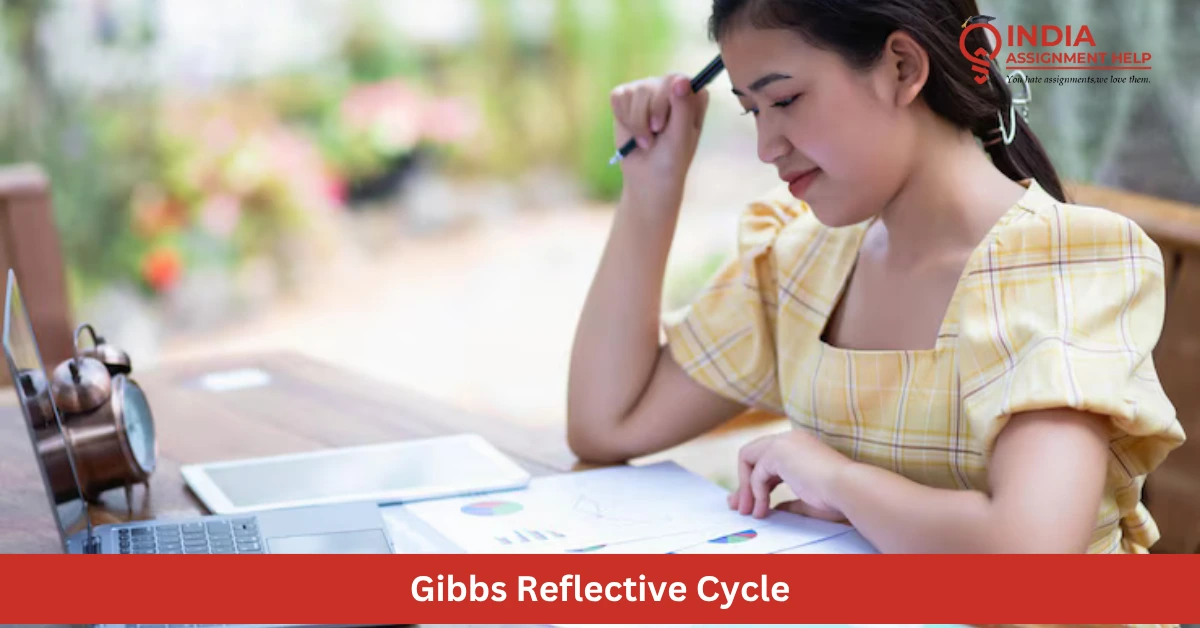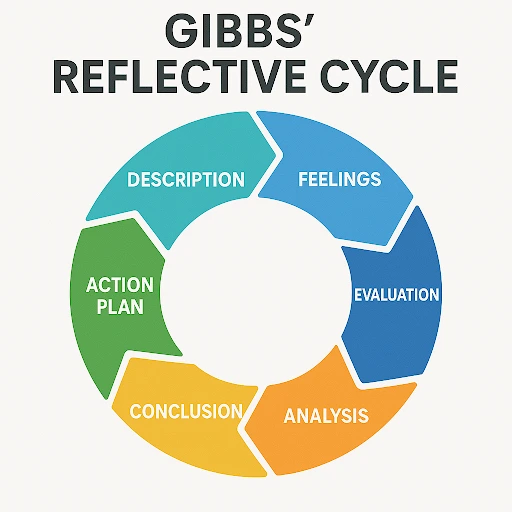Understanding Gibbs Reflective Cycle: A Simple Guide for Students

Oh! Don’t worry, you’ll learn from experience
You might have heard this phrase a million times from your parents, teachers, or seniors. But, have you ever really thought about how one learns from experiences? Reflection, that’s how! How was the first presentation you had ever given in your life? Not good? Thought so. However, I’m sure that it improved as you continued. How though? Reflection, again!
If you stop reflecting on experiences, stop thinking about how you could do it better the next time, you won’t ever learn anything at all! The Gibbs Reflective Cycle is basically your step-by-step guide to making sense of your failed moments and turning them into growth. In this guide, we’ll talk about what the Gibbs Reflective Cycle is, the 6 stages of the Gibbs Reflective Cycle, and its application.
What is the Gibbs' Reflective Cycle?
In 1988, Graham Gibbs designed a 6-stage process of reflection that helps you reflect on your life experiences—good or bad, and also helps you learn from them in a structured way.
Gibbs’ reflective cycle is a cyclic model that emphasizes revisiting your past experiences, analyzing them from different angles, and then using the insights for future learning and improvements. It was originally designed for nursing, but now it’s used in many professional and academic settings.
Why is it a cycle?
It’s a cycle because after the sixth stage, you go back to the first, and then you go through all 6 steps again to reflect on your experience. You keep cycling through, and you get better each time.
6 Stages of Gibbs Reflective Cycle

We all have new experiences every day—some of them go great, others not so much. Most people simply move on to the next thing, without really thinking about what just happened.
What if I tell you there’s a way to learn from all your experiences, and you just need to go through 6 simple stages? These 6 questions will help you figure out what happened and how to do better next time. But, what exactly are these 6 magical stages?
These 6 stages are Description (Tell the story of what happened) Feelings (Explore your emotions and reactions) Evaluation (Identify what worked well and what didn't) Analysis (Understand why things happened the way they did) Conclusion (Figure out what you've learned from it all) Action Plan (Decide what you'll do differently next time).
Don’t worry if you’re looking at these terms with no knowledge of what they actually mean - because we’ll walk you through each stage in detail!
1. Description
The description stage is the first stage in the Gibbs Reflective cycle - this is where it all begins! You start by simply telling the story of what happened. The goal here is to provide a clear, objective, and factual account of the experience. You can ask yourself questions like:
- Where were you?
- Who else was there?
- What were you doing?
- What actually happened?
Remember that you’re not judging yourself or analysing the situation at this point; you’re just recording the event. Let’s say you gave a presentation, and it didn’t go as planned. Here’s what you’re going to do when you get home and have a moment to yourself, describe that moment in detail and include things like:
- Context
- Sequence of events
- Partcipants (how many people were present there and how their presence impacted your presentation)
- Outcome of the event
Once you answer these questions, you can move to the next stage.
2. Feelings
In the second stage of Gibbs reflective cycle, you reflect on how you felt during the experience. You have to describe your feelings and emotions before, during, and after the event.
- Were you nervous at the beginning?
- Were you confused while it was happening?
- Did you feel embarrassed afterward?
- Did you feel happy after your experience?
The only thing that’s important here is that you have to be honest to yourself. Human beings have feelings and feelings aren’t always logical, but they do matter. This stage helps you recognise the emotional impact of the experience. Maybe, you were more confident than usual, or maybe you held back a little because you felt nervous. No matter how you felt - write it all down because this will help you make sense of your reactions.
3. Evaluation
Evaluating your feelings is the third stage of Gibbs Reflective Cycle. You have to critically asses all that happened during the event - what worked for you and what didn’t.
Let’s take the same presentation example again. Maybe your content was strong, but your delivery was shaky or maybe your team worked together well, but you didn’t manage your time properly.
You have to evaluate both positive and negative aspects of the experience, without being hard on yourself. While you’re evaluating your experience, try to answer what was missing that could have improved the situation?
Evaluation is where you begin to separate the helpful from the harmful. This stage helps you spot patterns—what tends to go right, and what always goes wrong? Once you figure that out, you can fix things next time!
4. Analysis
Stage 4 of the Gibbs Reflective Cycle is the analysis stage. This is where things get interesting. You now try to understand why everything unfolded the way it did. You have to make a list of these questions and try to answer them as honestly as possible.
- Why did I feel that way?
- Why did things go well in some parts and badly in others?
- Was I prepared enough?
- Did I misunderstand something?
- Were external factors involved?
You can try connecting your experience with theories, frameworks, or simple common sense. For example, maybe the reason you froze during your presentation was that you didn’t practice enough, or maybe you were too distracted by trying to make eye contact. This stage is all about cause and effect - what led to what? Once you understand the ‘why’, you’re already on your way to growth!
5. Conclusion
In the 5th stage of the Gibbs reflective cycle, you’ve to conclude everything you’ve learned so far about your experience from the past stages. This is when you ask yourself - What did I learn? How my thinking has changed? And what will I do differently the next time?
- What new insights do you have?
- What would you do differently next time?
- What strengths did you discover?
- What weaknesses do you need to work on?
The conclusion is like a summary of your learning. It helps you wrap things up in a clear way and sets you up perfectly for the next and final step.
6. Action Plan
Finally, the last stage that turns reflection into real change. The Gibbs reflective cycle doesn’t just tell you to learn from your past experience, but to make a concrete plan on how you want to use that lesson to improve your life and career going forward.
Let’s go back to the presentation example. If you learned that you need more practice before presentations, schedule practice sessions before your next one. If you discovered that time management is your weak spot, use a timer the next time.
This step is all about taking what you’ve learned and turning it into action - and that’s how growth happens. You apply your insights to the future. So, the next time you go through a similar situation, you’re already better prepared. Then the cycle begins again—with a new experience, a new reflection, and even more learning.
Application of Gibbs Reflective Cycle for a Student
Let’s understand through an example how a student can apply Gibbs reflective cycle to improve his academic and career prospects. Let’s say a final-year university student goes to interview for his first internship. He gives the interview but doesn’t get the opportunity.
How Gibbs' Reflective Cycle Can Help Him:
- Description – What happened? I Arrived 10 minutes late due to traffic and then stumbled through basic questions like "Tell me about yourself," gave one-word answers, and couldn't think of good examples when asked about past experiences.
- Feelings – How did I feel? I felt nervous before the interview, embarrassed during it when words wouldn't come out right, and devastated afterwards knowing it went badly.
- Evaluation – What went well and badly?
- Good: Dressed professionally and brought copies of resume
- Bad: Poor time management, no preparation for common questions, and froze under pressure
- Analysis – Why did this happen? I realise that I never practiced answering interview questions out loud. I didn’t plan the travel time, and that’s what made me nervous.
- Conclusion – What did I learn? I learnt that interviews require actual practice, not just thinking about answers in your head. I also learnt that I need to take care of other factors too and plan well in advance.
- Action Plan – What will you do differently?
- Research the company and role thoroughly beforehand
- Practice common interview questions with friends or in the mirror
- Prepare 3-4 specific examples of past successes using the STAR method
- Plan to arrive 15 minutes early, accounting for potential delays
- Do mock interviews with the career center
The Result: My next interview was much better because I was prepared and confident!
Final Thoughts
The Gibbs Reflective Cycle isn’t just for essays or assignments; it’s a life tool. You can use it to improve anything, from presentations and interviews to relationships and teamwork. Each stage gives you a chance to pause, think, and learn. Also, the more you practice it, the more natural it comes to you. So, the next time you experience something that makes you feel like it could’ve been better. Don’t just sit around and wait for the change to happen on its own. Reflect! Because even failures have lessons hidden in them. All you have to do is look and with Gibbs’ help, and you’ll know exactly where to start.
We hope you this guide helped you clear your doubts related to Gibbs Reflective Cycle. If you still find it difficult to understand and don’t know how to apply it your assignments, you can reach out to our team at India Assignment Help, and we’ll be happy to assist you further!





